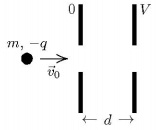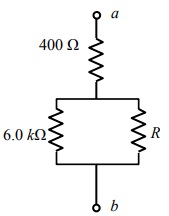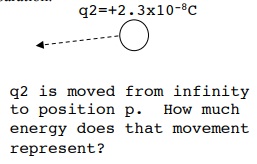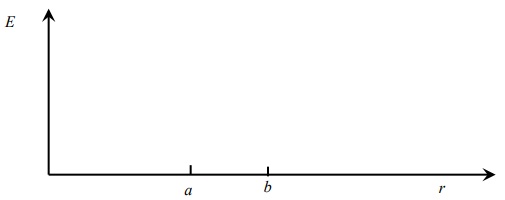Assignment:
1. A 2 µF and a 1 µF capacitor are connected in series and a potential difference is applied across the combination. The 2 µF capacitor has:
A. twice the charge of the 1 µF capacitor
B. half the charge of the 1 µF capacitor
C. twice the potential difference of the 1 µF capacitor
D. half the potential difference of the 1 µF capacitor
E. none of the above
2. Two concentric, imaginary spherical surfaces of radius R and 2R, respectively, surround a negative point charge -Q located at the center of the two surfaces. When compared to the electric flux through the surface of radius R, the electric flux through the surface of radius 2R is
A. Φ2 = 1/4 Φ1
B. Φ2 = 1/2 Φ1
C. Φ2 = Φ1
D. Φ2 = 2 Φ1
E. Φ2 = 4 Φ1
3. The diagram shows the electric field lines due to two charged parallel metal plates. We conclude that:

A. the potential of the upper plate is positive and the lower plate is negative.
B. a proton at X would experience the same force if it were placed at Y.
C. a proton at X experiences a greater force than if it were placed at Z.
D. a proton at X experiences less force than if it were placed at Z.
E. an electron at X could have its weight balanced by the electrical force.
4. A particular car battery has a rating of 80 A-hr. The Ampere-hour is a unit of:
A. power
B. energy
C. force
D. charge
E. none of the above
5. Capacitor 1 has twice the capacitance of capacitor 2. Both capacitors are connected in parallel to a battery and are fully charged. What is the ratio of energy storage of capacitor 1 to capacitor 2:
A. 1 : 4
B. 1 : 2
C. 1 : 1
D. 2 : 1
E. 4 : 1
6. A particle with mass m and charge -q is projected with speed v0 into the region between two parallel plates as shown. The potential difference between the two plates is V and their separation is d. The change in kinetic energy of the particle as it traverses this region is:
A. -qV/d
B. 2qV/mv02
C. qV
D. mv02/2
E. none of these

7. Two small charged objects attract each other with a force F when separated by a distance d. If the charge on each object is reduced to one-fourth of its original value and the distance between them is reduced to d/2 the force becomes:
A. F/16
B. F/8
C. F/4
D. F/2
E. F
8. Five cylindrical wires are made of the same material. Their lengths and radii are
wire 1: length l, radius r
wire 2: length l/4, radius r/2
wire 3: length l/2, radius r/2
wire 4: length l, radius r/2
wire 5: length 5l, radius 2r
Rank the wires according to their resistances, from the least to the greatest.
A. 1, 2, 3, 4, 5
B. 5, 4, 3, 2, 1
C. 1 and 2 tie, then 5, 3, 4
D. 1, 3, 4, 2, 5
E. 1, 2, 4, 3, 5
9. When a positive charge moves along an electric field line, it moves to a position of
A. lower potential and lower potential energy.
B. lower potential and higher potential energy.
C. higher potential and lower potential energy.
D. higher potential and higher potential energy.
E. greater magnitude of the electric field.
10. Three resistors are wired together as shown in the diagram below. It is desired to have a total effective resistance between points a and b of 4.0 kΩ. What must R be in order to achieve this result?
A. R = 1.0 kΩ
B. R = 2.0 kΩ
C. R = 4.0 kΩ
D. R = 6.0 kΩ
E. R = 9.0 kΩ

For these problems you must clearly show how you obtained your answer. A complete answer will include a diagram with labels, if appropriate.
Circle your answer. Use the back if necessary.
11.) A particle with a charge of -3.5x10-8 C is located 5.5 cm from a second particle with a negative charge of +2.3x10-8 C.
(a) Determine the change in electrical potential energy for this two particle system, relative to the electrical potential energy when the two particles have infinite separation.


(b) What is the magnitude of the Electric Field that particle 1 generates at point P ?
(c) When particle 2 arrives at point P what is the force that particle 2 feels?
12. A hollowed out, thick, conducting sphere has inner radius a and outer radius b.
a) What is the volume of material that comprises the thick conducting sphere?
b) If a charge 5Q were placed precisely in the center of the spherical shell, what would the area charge density of the inner spherical surface be?
c) Continuing from part (b) above, what would the area charge density of the outer spherical surface be?
d) Still continuing from part (b), What is the E-field at a location between radius a and b?
e) Plot the E-field (vertical axis) vs radial distance from the center (horizontal axis). Assume the 5Q charge mentioned in part (b) is still present at the center of everything.

13. A 1-meter long wire lies along the x-axis and has a linear charge density, λ, of 5.0 µC/m that is uniform along the wire. Consider an imaginary, spherical surface with a radius of 8.0 cm placed so that the wire runs through the center of the sphere. Determine the total electric flux through the spherical surface.
Note: If this problem had asked for the E-field or something similar, you would want to discard the sphere and consider a cylinder of length 2R (to match the sphere's diameter). However, since it just asks for the flux, remember the full definition of what Gauss' Law is all about:
14. A parallel plate capacitor is hooked up to a battery. The distance between the plates is 5mm and the electric field between them is 800 N/C. The mass of an electron is me = 9x10-31 [kg].
a) What is the voltage of the battery?
b) If an electron starts at the negative plate from rest, how fast is it traveling just as it hits the positive plate?
c) Suppose the distance between the plates is doubled while the battery is still hooked up. If the electron leaves the negative plate from rest, how fast will it be going when it reaches the center of the gap (which means it went the same 5mm distance as it did in part (b)).